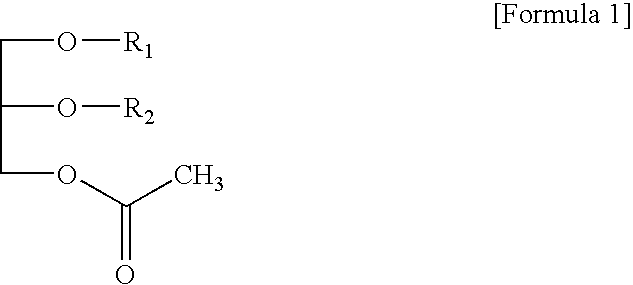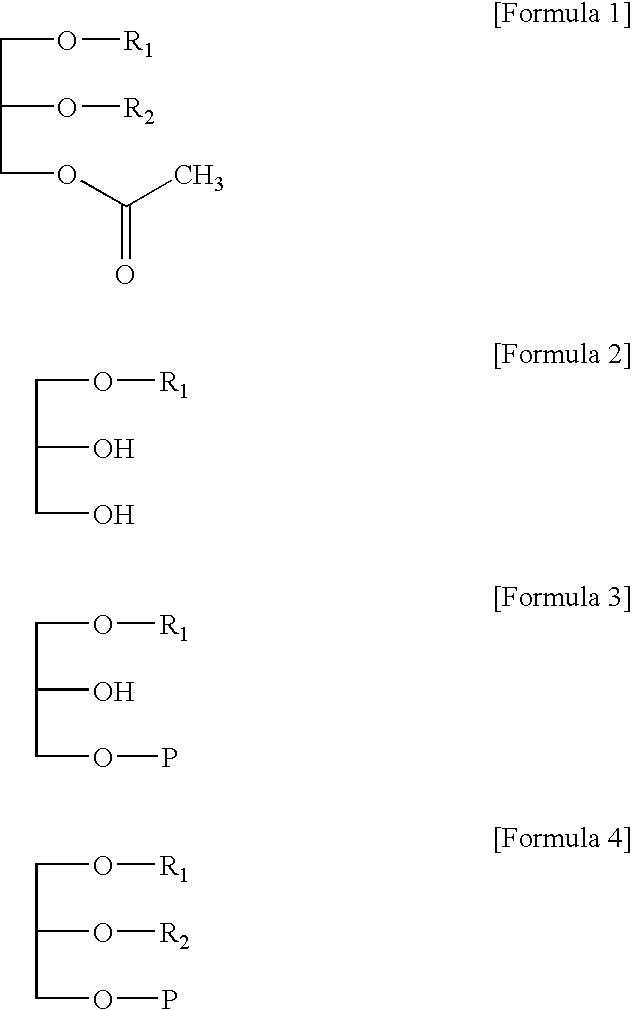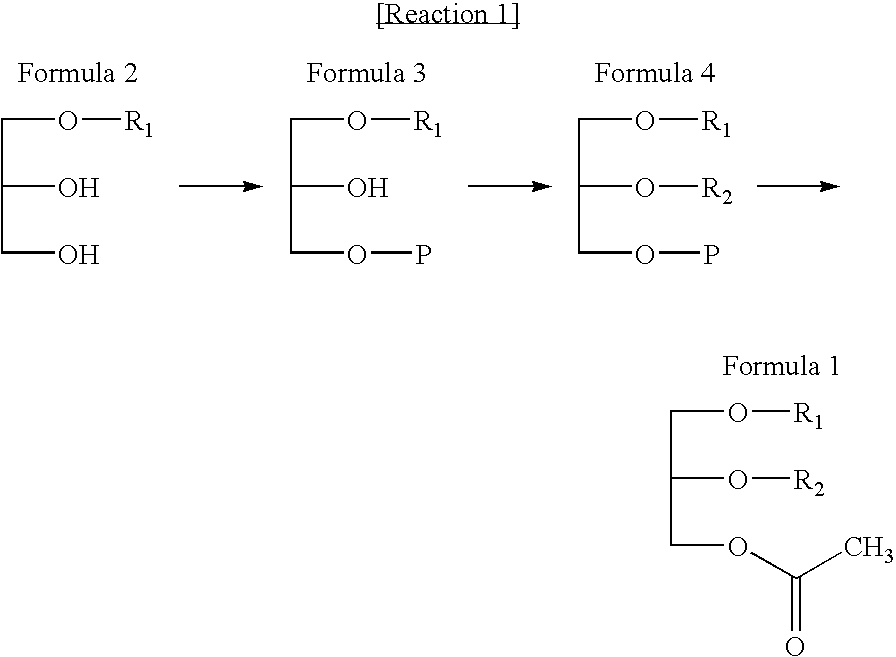Preparation of glycerol derivatives ad intermediates therefor
a technology of glycerol and derivatives, which is applied in the preparation of organic compounds, fatty acid esterification, organic chemistry, etc., can solve the problems of low yield and inability to produce the target compound in a large amount by the method, and achieve good efficiency and yield
- Summary
- Abstract
- Description
- Claims
- Application Information
AI Technical Summary
Benefits of technology
Problems solved by technology
Method used
Image
Examples
example 1
Preparation of 1-palmitoyl-3-trityl-glycerol
[0025]1-palmitoyl-glycerol (33.0 g), pyridine (48 ml) and trityl chloride (31.3 g) were added into 1 L reactor. The reaction mixture was heated to 60° C. while stirring, and the reaction was carried out for 3 hours. After completion of the reaction, cooled water (240 ml) was added slowly into the reaction mixture. The reaction mixture was further stirred for 1 hour, and then filtered. The obtained solid material was washed with cooled water (120 ml), and then dried at 40° C. to obtain 57.3 g of 1-palmitoyl-3-tritlyl-glycerol (yield: 100%) {1H NMR (400 MHz, CDCl3): δ 0.89-0.93 (t, 3H), 1.21-1.31 (m, 24H), 1.57-1.61 (m, 2H), 2.31 (t, 2H), 3.25 (d, 2H), 3.97-4.02 (m, 1H), 4.16-4.27 (m, 2H), 7.22-7.47 (m, 15H)}.
example 2
Preparation of 1-palmitoyl-3-t-butyldimethylsilyl-glycerol
[0026]1-palmitoyl-glycerol (33.0 g), dichloromethane (330 ml) and imidazole (13.6 g) were added into 1 L reactor, and the reaction mixture was cooled to 0° C. Then, t-butyl-dimethylsilylchloride (18.0 g) was added, and the reaction mixture was stirred for 2 hours. After filtering the reaction mixture, the solvent was removed by distillation under reduced pressure, and purified water (165 ml) and heptane (150 ml) were added for an extraction. The separated organic layer was extracted with purified water (80 ml) again, and then the organic layer was dehydrated with anhydrous MgSO4, and filtered. Then, the solvent was removed by distillation under reduced pressure to obtain 1-palmitoyl-3-t-butyldimethylsilyl-glycerol (yield: 100%) {1H NMR (400 MHz, CDCl3): δ 0.78-0.83 (m, 18H), 1.18-1.31 (m, 24H), 1.50-1.56 (m, 2H), 2.24 (t, 2H), 3.51-3.60 (m, 2H), 3.76-3.79 (p, 1H), 4.01-4.10 (m, 2H)}.
example 3
Preparation of 1-palmitoyl-2-linoleoyl-3-trityl-glycerol
[0027]1-palmitoyl-3-tritylglycerol (57.3 g), which was obtained in Example 1, heptane (300 ml), linoleic acid (29.4 g) and dimethylaminopyridine (0.122 g) were added into 1 L reactor. Dicyclohexylcarbodiimide (21.7 g) was added into the reactor, and then the reaction mixture was stirred for 3 hours at room temperature. Dicyclohexylurea was filtered to obtain heptane solution of 1-palmitoyl-2-linoleoyl-3-trityl-glycerol (expected yield: 100%) {1H NMR (400 MHz, CDCl3): δ 0.92-0.95 (m, 6H), 1.33-1.43 (m, 36H), 1.60 (m, 2H), 1.69 (m, 2H), 2.09-2.11 (m, 4H), 2.26 (t, 2H), 2.27 (t, 2H), 2.83 (t, 2H), 3.31 (m, 2H), 4.24-4.42 (m, 4H), 5.31-5.41 (m, 5H), 7.21-7.49 (m, 15H)}.
PUM
| Property | Measurement | Unit |
|---|---|---|
| temperature | aaaaa | aaaaa |
| temperature | aaaaa | aaaaa |
| temperature | aaaaa | aaaaa |
Abstract
Description
Claims
Application Information
 Login to View More
Login to View More - R&D
- Intellectual Property
- Life Sciences
- Materials
- Tech Scout
- Unparalleled Data Quality
- Higher Quality Content
- 60% Fewer Hallucinations
Browse by: Latest US Patents, China's latest patents, Technical Efficacy Thesaurus, Application Domain, Technology Topic, Popular Technical Reports.
© 2025 PatSnap. All rights reserved.Legal|Privacy policy|Modern Slavery Act Transparency Statement|Sitemap|About US| Contact US: help@patsnap.com



